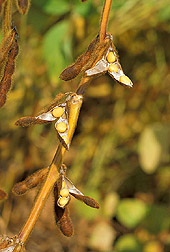This page has been archived and is being provided for reference purposes only. The page is no longer being updated, and therefore, links on the page may be invalid.
|
|
New Soy Germplasm Lines Available for BreedingBy Jan SuszkiwJuly 14, 2004 High-quality seed--and plenty of it--could be on tap for new soybean cultivars bred from three new germplasm lines developed by Agricultural Research Service scientists and cooperators. The new soy releases--LG97-7012, LG98-1445 and LG98-1605--are the result of a 20-year cooperative effort in which ARS and University of Illinois scientists crossbred commercial varieties with exotic strains of the bean maintained at the ARS Soybean/Maize Germplasm, Pathology and Genetics Research Unit in Urbana, Ill. Besides increased yield, the germplasm releases should help broaden the genetic base of the nation's $15.2 billion soy crop, according to Randall Nelson, who leads the ARS unit and curates USDA's Soybean Germplasm Collection at Urbana. The first two releases owe 25 percent of their genetic makeup to Asian beans collected in the 1930s and 1950s. The third, LG98-1605, is 100 percent exotic, making it only the second germplasm release of its kind to be released for use by U.S. breeders, according to Nelson. Of the three, LG98-1445 had the highest average seed yield during field trials in 2001 and 2002 at 28 different locations in 10 states. The release also outperformed the commercial check variety used in those tests. LG97-7012, but not the other two releases, is resistant to the fungus Phytophthora sojae, which can cause root and stem rots. The three releases are intended as germplasm stock for breeding new, finished varieties. Read more about the research in this month's issue of Agricultural Research magazine. ARS is the U.S. Department of Agriculture's chief scientific research agency. |

